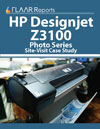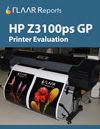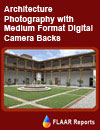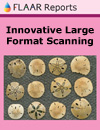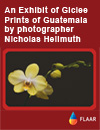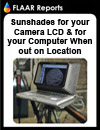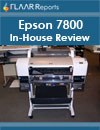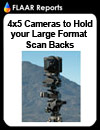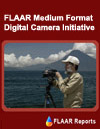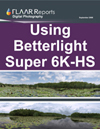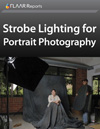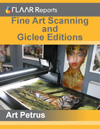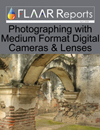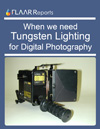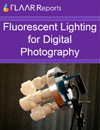Canon EOS-1Ds Mark III digital camera review
This digital camera review of the Canon EOS-1Ds Mark III is based on actually owning this camera. This is not a pseudo-review by someone who borrows a different camera every week to crank out sham-reviews to snooker people to buy them.
Furthermore, we are not Canon evangelists: we are not Nikonians either. We use whichever brand and model of camera which is optimal for the applications and needs of the task at hand.
And most importantly, FLAAR Reports is one of the few remaining review web sites that is independent enough to a
ctually list the foibles, issues, and downsides of any brand of camera. I can still remember when Kodak refused to provide me their last model of digital camera. I published their refusal within 24 hours of them refusing. 12 hours later the camera was on the breakfast table for me to evaluate!
FLAAR is a research and educational institute for many decades. We have been evaluating digital cameras since 1997. That’s how we are the ones who own the web site name, www.digital-photography.org; we started early in the era of digital photography, when a 4 MB digital camera cost about $28,000, required a SCSI card, and the camera was tethered by SCSI cable to your computer!
We acquired a Canon EOS-1Ds Mark III in late 2010 and have taken it out on three field trips in Guatemala, Central America.
If we were a pseudo review we would try to use smoke-and-mirrors by posting the spec sheet in a really slick looking tabulation. But we hope you are sophisticated enough to smile when you see those kind of web sites. Often they simply copy-and-paste whatever is on the manufacturer’s web site.
 |
|---|
| Canon EOS-1 Ds MarkIII |
Downsides
I will find an issue, quirk, or downside eventually, but for present can’t think of one. Frankly the photos that Canon uses to advertise their cameras are often rather mediocre. The photos we are achieving with this camera actually look better than many in the Canon camera company brochures.
I don’t find the price a negative factor: you get what you pay for. If you want a $2000 camera or a $3000 camera or a $1500 camera, Canon makes something for everyone. If you want the best camera that Canon can produce, then this is it (obviously an even better one will be out tomorrow, but I am plenty content with what I have so don’t feel a need to wait for the next-best-thing).
Comparison between Canon EOS-1Ds Mark III and medium format
But no matter what, there is not yet anything to convince me that this camera can inherently take a better photograph than a medium-format camera. The sheer beauty of a medium format image is a pleasure to behold.
Yet a 35mm DSLR can do better bird photography because there is no medium format lens that can focus on a bird far away and show the bird full-screen.
Plus there is no medium format lens that can even come close to the Canon MP-E 65mm macro, with 5x magnification. I have a Hasselblad 120mm macro lens and focusing bellows: great for its day, but that day was twenty-five years ago. If you are photographing a butterfly egg, a medium format sensor is too large; a 35mm sensor is fine, especially at 5x.
But for landscapes and panoramas, for photography of art and artifacts, for architectural photography: here is where a medium format camera is a world of its own. I used Leica cameras for decades: in the 1960’s their mantra was that once you had a Leica you had the best in the world.
Then I got a Hasselblad, and found it so much better than a Leica that I went on to buy two more Hasselblads. I used my Leicas only when I needed smaller images or when I needed 35mm slides for a Kodak carousel tray lecture.
I then experimented with 4x5” large format and found it so much better than Hasselblad medium format there was almost no comparison.
Then I moved up to 8x10” The quality of an 8x10 chrome is irreplaceable. But today is the year 2011 and I have not used film, not of any size, is over fifteen years. But the image from a Zeiss lens recorded on a CCD filter with any good medium format back is still a pleasure to see.
But when I need a light portable camera; when I am in a hurry, or when I need a lens that is not readily available via Hasselblad (115 degree angle of view from 14mm on the Canon; or 100-400mm zoom), then I am content with the Canon. Besides, 90% of my photographs will be seen on the Internet or in publications. They don’t need to be viewed at billboard size.
 |
|---|
| Canon EOS Rebel T2i |
 |
|---|
Canon EOS 1 Ds Mark III |
Images to better review Canon EOS-1Ds Mark III
Every time I see the claim “unbiased review” I never know whether to smile, smirk, laugh, or cry. These are what I call pseudo-reviews: the people writing them are rarely actually using the camera out in the real world.
I have no need to hide my bias: I am biased to Success Stories, which normally are just paid PR or suck-up reviews.
FLAAR has listed one Canon camera as the worst we ever evaluated (EOS 1D Mark III), and we have found two Nikon lenses as inadequate. One Nikon lens we consider low-bid junk. Even a lens made in China might have been better (low-bid Nikon lenses are made in Thailand).
So if you want a fun, slick review of a Canon or Nikon camera or lens, go to any of the dozens of commercial review sites. If you want to hear only good news on Nikon, go to the Nikonians. Twice (once at PMA and once at Photokina) I have spoken with them in-person about the junky Nikon lenses and they had no interest in hearing this.
The FLAAR Reports are one of the few review sites on the Internet that does not suck up to camera manufacturers. We are different from Nikonians in that we are not of the Nikon religion. I can still remember the Mac (Apple) evangelists who came to me at a trade show and said, seriously, “Nicholas you write as if you have lost the faith.”
A camera, a lens, like a computer, is simply a piece of metal and plastic and glass. I can be a Catholic or Muslim or Buddhist and still write an evaluation on a camera, or on a computer. I use a Mac but I let my employees select whichever platform they prefer: some like Mac; others prefer to use PC.
So if you want a review on Canon from a Canon Explorer of Light, you will get precisely what and why Canon pays them: to them, everything Canon does and makes is great. You rarely hear them saying the lens shade on Canon camera lenses are an embarrassment.
If you want a review about Nikon where everything is perfect, then go to Nikonians or comparable.
Or go to any web site that sells Nikon and/or Canon and makes money from selling you one or the other.
We are not adverse to money: but we would rather list the actual weak points and issues with a camera than receive lots of money for saying only how wonderful a camera is.
Price comparison of Canon EOS-1Ds Mark III
There is no Sigma, Pentax or Olympus camera with full frame sensor, so that rules them out. Pentax, Olympus, and Sony have an inadequate choice of lenses to select from. Nikon has twice to three times as many lenses, and Canon offers about any and every lens you could possibly desire.
But somehow the Nikon 3D series cameras never caught my attention. I have been a Nikon user since late 1980’s. I had utilized only Leica cameras since age 16, and had a Leica R3, Leica R4, and Leica R5. But when I needed an ultra-wide angle lens, it was less cost to buy a Nikon F3 High Eyepoint camera plus the Nikon 15mm lens than it was to buy a Leitz 15mm lens. So I began my gradual move to Nikon. I still used my Leica cameras through 1995. In 1996-97 I evaluated the early Kodak DCS 420 digital camera and then the next model (each was $28,000 but the national museum of ethnology, outside Osaka, provided each model for several months to evaluate). Then I went home to Florida and bought a Nikon Coolpix to experiment with digital cameras on my own. A year or so later I acquired the Nikon D100.
I never used my Leica cameras after about 1997. I never used my Hasselblad cameras with film after about 1998. Today, in 2011, I am preparing to donate my three Leica cameras and the Nikon film-based camera to the archaeology institute in Guatemala, since they prefer to use film than digital.
What is a downside? What is an issue? What is a con?
The cheap plastic lens shades look like they are made by some low-bid manufacturer in China. They look like they cost about $1.99 cents worth of cheap plastic.
Why does Canon try to squeeze more profit by providing such junk?
The engineer who designed the lens shades screw-on attachment system should go back to engineering school, but first he or she should apologize. Second, he or she should have to place the lens hood on and off the lens while in use several times to see why it is so inadequate.
Neither the front of the lens nor the screw portion of the lens shades works acceptably. It makes the Canon lenses look cheap and rinky-dink, which is a pity, since the Canon lenses of themselves are fine (so far none of our Canon lenses has fallen apart as fast as has the cheap Nikon zoom lenses).
The Canon lenses are fine (so far). The Canon EOS-1Ds Mark III camera is outstanding. The only thing that is awful are the lenses hoods: all of them by the way: Canon 100 macro and Canon 180mm tele macro.
Macro lenses
For the last several years we have had two Canon macro lenses (for use with the EOS 5D)
- Canon MP-E 65mm f/2.8 1-5x Macro Photo lens
- Canon EF 100mm f/2.8 Macro USM lens
 |
|---|
Canon MP-E 65mm f/2.8 1-5x Macro Photo lens |
 |
|---|
Canon EF 100mm f/2.8 Macro USM lens |
We do not need the IS “Canon Hybrid Image Stabilization Technology” because you should always use a tripod if doing macro photography. So we did not acquire the EF 100mm f/2.8L Macro IS USM
- Recently we acquired the EF 180mm f/3.5L Macro USM since my Nikon 200 tele-macro is over 15 years old and hence has no auto-focus. When photographing with wildlife there is not normally time to focus manually.
 |
|---|
Canon EF 180mm f/3.5L Macro USM |
These three macro lenses cover about everything we would ever need for photographing insects, seeds, and details on anything else.
Telephoto lenses
The high cost of super telephoto lenses has kept me from purchasing any telephoto lens beyond the 100-400mm zoom lens that is good for basic wildlife at a fair price. There is no 200-500mm zoom lens (Sigma makes a zoom that goes up to 500mm). Downside of Sigma lenses is that they are slow to focus. I would never even consider a Tamron or other brand of after-market lens. The lens quality is what made Leica cameras the best in the world for many decades. Canon lenses are acceptable, though I will admit I am spoiled by Zeiss lenses for Hasselblad and Leitz lenses for Leica.
If you are photographing in a zoo, or in a nature park, the water birds are probably more accustomed to visitors. But out in the wild, out in the actual rain forest, the water birds fly away once they see you coming in their direction. And in a boat you don’t have a means to use a tripod. The image stabilizer is some help, but not enough. Once the bird is in flight all you can get is a pretty snapshot.
So a Canon EF 500mm f/4L IS USM or EF 600mm f/4L IS USM lens would be better for water birds. The Canon EF 800mm f/5.6L IS USM lens would allow you to shoot from further away, before the bird gets spooked. But for the smaller birds, you would not see them at this distance. Plus the telephoto is about $12,000, or more, by the time you buy the extras. As a non-profit institute we can’t afford a twelve thousand dollar lens.
What else would we be tempted with from Canon ?
EF-S 10-22mm f/3.5-4.5 USM offers close-focusing to 9.5 inches which means you can fill the screen with an object 3.6 x 5.4 inches. I would be interested in seeing the wide-angle effect. In real life this is a 16-35mm zoom for Digital Rebel or any Canon camera that does not have a full frame sensor. The EF 16-35mm f/2.8L II USM is essentially the same lens, simply marketed for full-frame sensor (and twice the price of the other model). But this lacks close focusing: only .92 feet or 28 cm.
Obviously to actually take a photo so close would be tough for anything on the ground (we use a tripod for 95% of our photographs).
We have no need for a fisheye lens since we record botanical, zoological, architectural, and archaeological subjects. A “true” view is essential. A fisheye view would be too faked and too distorted. Nowadays you can do better with a GigaPan and can remove a lot of the distortion from this kind of photo.
But we definitely need a basic wide-angle lens in addition to the extreme wide-angle 14mm lens. The 16-35mm zoom would definitely cover all options for these needs. But the 17 to 40mm zoom is at a more reasonable price. Of course I am still always nervous that a zoom lens does not have the precision of a prime lens.
I would also be tempted by the Extender EF 1.4X III, especially since it is compatible with the EF 100-400/4.5-5.6L. I might be even more tempted with the Extender EF 2x III.
What about tilt-shift lenses for digital photography?
Since FLAAR does architectural photography around the world, we are naturally interested in any lens that offers tilt-shift. The delay in jumping to buy one are all the observations that light coming in at an angle (to a sensor) may not be fully or accurately handled. Most sensors need the light coming in from the front (when possible).
But medium format and large-format cameras offer tilt and shift, rise and fall, with Schneider and Rodenstock lenses. Plus Dr Dork offers tilt-shift lenses too. And now Schneider is attempting to get into this market. Hasselblad has tried, but I am not convinced that their system has enough space in the lens to handle much movement.
In other words, if you really need tilt-shift, you probably need a Silvestri, Cambo, Sinar arTech or comparable camera.
But if tilt-shift lenses were available for evaluation, I would be tempted by the
- Canon TS-E 17mm f/4L lens
- Canon TS-E 24mm f/3.5L II lens
Since a wide-angle lenses is normally needed for architectural photography, I would not be as tempted by the 45mm or 90mm tilt-shift lenses.
Acknowledgements
We thank John Lorusso, Parrot Digigraphic for providing a Canon EOS-1Ds Canon camera for evaluation, plus the following lenses:
- EF 14mm f/2.8L II USM; angle of view is 114 degrees
- EF 100-400mm f/4.5-5.6L IS USM
- EF 180mm f/3.5L Macro USM
 |
|---|
Canon EF 14mm f/2.8L II USM |
 |
|---|
Canon EF 100-400mm f/4.5-5.6L IS USM |
We already had the following Canon lenses for an older Canon EOS 5D body.
- MP-E 65mm f/2.8 1-5x Macro Photo lens
- EF 100mm f/2.8 Macro USM lens
Trustworthy information: information that is not just trying to sell you something
Google Canon EOS Beginners’ FAQ III – Lenses and you will get a helpful review that does not appear to be a suck-up pseudo review. He (or she? NK Guy) covers almost all lenses. It is like a combination of a glossary and a FAQs introduction.
First posted January 12, 2011.
Free Reports (Inquiry Form)
Additional links of our FLAAR sites |
| Rigid Printable Materials |
| Printing on Glass |
| Sandwich board for recyclable furniture! |
| Metallic Effects |
Free Download Reports
| Home | About Us | Consulting | About FLAAR Reports | Site Map | Privacy Statement | back to top | |||||
|
|||||||||||
www.digital-photography.org is part of the FLAAR network © 2001-2021. If you notice a bad link, missing photos, misspellings, please report to the webmaster: |
|||||||||||


